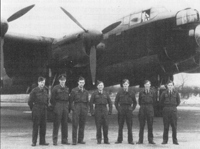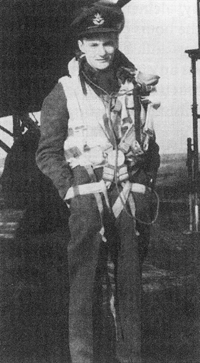This week marks the 60th anniversary of the end of the Second World War. Peter Hurcomb gives a dramatic account of the war-time experience of Stewart Harris and the rehabilitation he has received at St Dunstan's, the visual impairment charity for ex-servicemen which is celebrating its 90th annversary
In February 1943, Flying Officer Stewart Harris and his fellow crew-members were posted to 50th squadron, flying a Lancaster bomber. An early mission to the German naval port of Wilhelmshaven almost ended in disaster. The pilot embarked on a rapid descent to avoid anti-aircraft fire and would have flown into the sea were it not for the strong language of the bomb aimer telling the pilot to gain some altitude. Fortunately, the only casualty to the water was a radio aerial.
 |
| St. Dunstan's training centre at Ovingdean (Photograph courtesy of St Dunstan's) |
The following evening, on a night off Harris passed out. To elicit the cause of his blackout, the examining medical officer asked him: 'Have you been under any stress recently?'
After nearly four months of combat experience the crew were now posted to the newly formed 619 squadron. On the first mission with their new squadron, the crew ran into problems over the North Sea as the air speed indicators failed. They decided to continue on the mission. After crossing the enemy coast they were attacked by an enemy night fighter. Both planes were mortally crippled in the engagement. Even after the Lancaster jettisoned its bombs and with two of the engine fires out, the pilot was still struggling to keep the plane level. With the possibility that the remaining engine fire could ignite vapour in the empty wing fuel tanks the choice was simple: bail out or be blown out.
The crew bailed out over occupied Belgium. Locals assisted Harris, who was on his own, by donations of a jacket to disguise his uniform, some Belgian currency and a bicycle. A patriotic Belgian gendarme re-holstered Harris's pistol and advised him of a route to avoid the enemy troops sweeping the area looking for the aircrew.
Harris made contact with the resistance and after his story was confirmed by London he was passed between safe houses in Louvain and Brussels. To assist in his escape, his uniform was exchanged for civilian clothes and he was supplied with fake identity papers.
In the middle of one night, the enemy made a surprise visit to his safe house. Harris was bundled out of bed and forced into a secret cavity in the eaves of the roof by the lady of the house. After three hours, when the noise had died down, he came out of his hiding place. As he was getting dressed the door burst open and in walked two armed Gestapo agents.
GESTAPO INTERROGATION
 |
| Stewart Harris (second left) and crew in 1943 (Photograph courtesy of Stewart Harris) |
After several months in captivity, Harris was in a bad physical shape due to malnutrition. The diet in the Stalag comprised boiled barley, dark bread and a little margarine; this was supplemented by food from Red Cross parcels. Following a visit from the Swiss medical board, in the spring of 1945, Harris's asthma and malnutrition were severe enough to warrant an early repatriation to the UK. After 20 months in captivity, he was on his way home.
A possible permanent commission in the RAF was ruled out after a medical examination revealed peripheral retinal degeneration. The trigger to the visual problem was stated as the period of malnutrition.
An alternative career followed in the oil industry, firstly in South Africa and then in the UK. After several years gaining experience of the industry, and with just central vision and a supportive wife, they set up Trident Petroleum, their own independent oil distributor. This successful company was undone by the 1973 oil crisis. At about the same time that the company was wound up, Harris was practically blind.
 |
| Flying Officer Stewart Harris, 1943 (Photograph courtesy of Stewart Harris) |
This was followed with managerial consultancy work in both the petroleum and manufacturing industry. Harris also sat on the council of the Institute of Petroleum (the representative body of the UK oil industry) and was also the chairman of the London branch. A career summary may be found in Debrett's People of Today.
With the gradual deterioration in his vision, Harris became a beneficiary of St Dunstan's in 1977. One of his best decisions was to attend the St Dunstan's National Centre at Ovingdean for a three month training session. Here he learnt to touch type, use Braille and improve his mobility. The session also taught Harris to accept the loss of sight and steered him on the path to overcoming visual impairment.
FOUNDER OF THE CHARITY
Sir Arthur Pearson, who was blind as a result of glaucoma, had founded St Dunstan's in 1915 to provide care and rehabilitation for visually impaired personnel returning from the First World War. The charity enabled individuals to develop careers, for example in physiotherapy or as telephone switchboard operators, and carry on with their lives, rather than have a lifetime of isolation and dependency upon others. By 1918 new skills had been taught to over 1,500 men and women.
The entry requirements for the charity are those individuals who have served in the UK armed forces and have a visual acuity below 6/60. The admission criteria were widened in 2000 from military personnel in the UK armed forces who had suffered severe visual impairment as a direct result of their service to any ex-service personnel with visual impairment resulting from any factor such as accident, disease or age. Individuals who served in the Polish forces under British command or in the Merchant Navy during the Second World War are also eligible.
St Dunstan's, through the Diana Gubbay Trust, also provides the same service to those of the emergency services who have suffered a visual impairment in the course of their duty. Presently, admissions to St Dunstan's are at their highest level since the Second World War, and this trend is expected to continue for some time. Beneficiaries currently range in age between 16 and 108.
LIFETIME COMMITMENT
St Dunstan's makes a lifetime commitment to support each beneficiary, while also providing assistance to their families. The charity assists members to overcome their visual impairment and maintain their quality of life through rehabilitation, training, care (welfare, medical, housing), and residential/respite care. 'St Dunstaners' not only cope with visual loss but on many occasions also suffer from accompanying physical difficulties picked up during their time in the armed services. The vast majority of St Dunstaners live independently in the community.
St Dunstan's has two training centres, one recently opened in Sheffield, and the second at Ovingdean, near Brighton, which was purpose-built to provide training, support and rehabilitation skills for independent living. Ovingdean provides facilities for full-time residents, respite care and short-term visitors at training courses.
The training and moral support help individuals come to terms with their visual impairment and show them the opportunities that are still there.
New members to St Dunstan's spend an introductory week at Ovingdean with the Rehabilitation and Training Officers for the Visually Impaired (ROVIs) to discuss the various training and equipment that would most suit their needs. Training is supervised by ROVIs at Ovingdean and in the beneficiary's home.
The areas covered by the ROVIs in the training sessions are:
Welfare officers, who are members of staff at St Dunstan's, regularly visit those living in the community to ensure their living conditions are safe and comfortable and provide any additional services which may be required. The welfare officer also provides a link between the St Dunstaner and the local authority, social services and ex-service organisations.
FURTHER INFORMATION:
More detail on the work of St Dunstan's can be obtained from www.st-dunstans.org.uk. Optometric patients who could benefit from the services provided by St Dunstan's may contact them on: 0800 389 7979.
